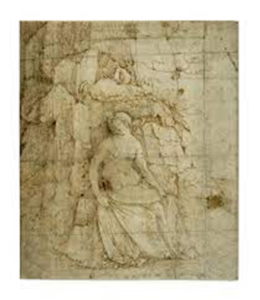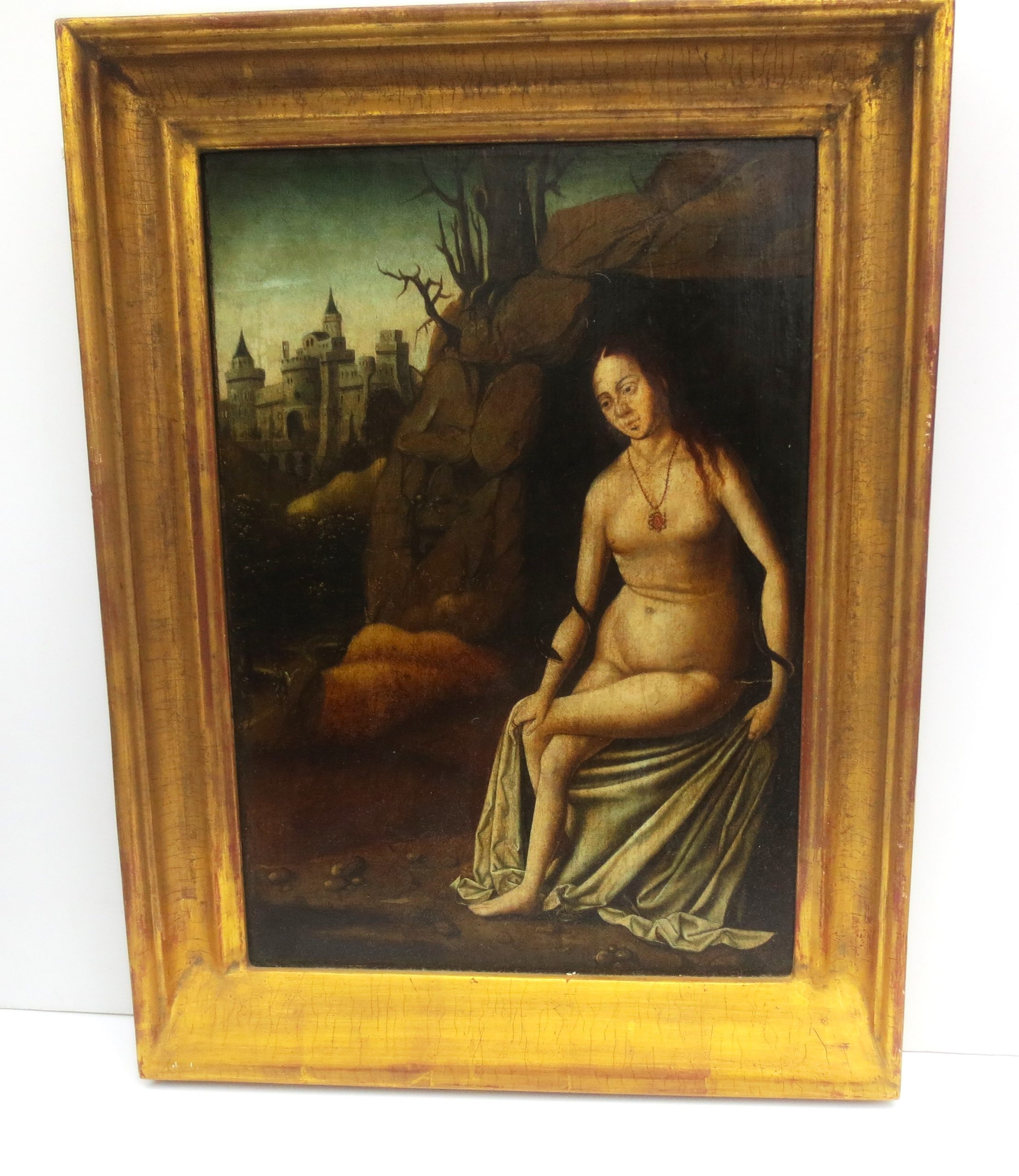Elusively peripatetic, of uncertain age and training, his name altered with each venue, Jacopo did produce one outstanding masterpiece in his immense panoramic bird’s eye view of Venice, meticulously detailed and brilliantly executed as a virtuoso woodcut published by Anton Kolb in Nuremberg. De’ Barbari matched that virtuoso performance with an equally impressive trompe l’oeil of a partridge, crossbow bolt and iron glove hanging on a door panel (Munich; Alte Pinakothek; oil on wood, app. 20 x 16 in, signed and dated 1504), a direct antecedent of the equally famed trompes a generation later by Lucas Cranach and centuries later by the American William Harnett.
A stylistically homogeneous group of de’ Barbari’s rare but unique figure paintings were done in a protean campaign during his first years in Nuremberg, primarily portraits of saints, Christ, and Albrecht von Brandenburg; a painting of an Ungleiches Liebespaar (“Unequal Pair,” jibing the misalliance of old and ugly with young and comely) was also clearly aimed for a local audience which made much of these mockeries. Of varying quality, the general style of all these earlier paintings (the latest dated 1508) have strong affinities with the style of Albrecht Dürer as transmitted by a wide circle of his followers in Franconia. As these early paintings dated up to 1508 were on Linden wood panels common to southern German paintings of the sixteenth century, they form a fixed body of de’ Barbari’s work by 1598 in Nuremberg. Conversely, the Cleopatra was painted on an oak panel, chamfered and thinned to fit the rabbet of an integral frame as befit the common materials and practices of Netherlandish artists in the early sixteenth century. It may be supposed therefore that this painting originated in Brussels sometime after 1508 but before 1516, the conclusive terminus ante quem for de’ Barbari’s adaptation of his style to the tastes of his new market.
As a painting created for market in his new venue, the composition of the Cleopatra formed the third member of a triad that included a drawing and an etching of variants on the same basic composition for the subject, cannibalized as selectable parts mixed and matched in three different materials and formal variants of the same picture. The probable genesis of this trio began with a drawing, followed by an etching and then the painting. Each was made up of component parts from the other two, yet none was the same and each different in original elements as well. It might be inferred that in that process the drawing was the primary invention, the etching a replication aimed at a wider popular market, and the painting a costlier work intended for the local elite and the courtiers active between Brussels, Antwerp and Mechelen where de’ Barbari had some contacts with the court of Margaret of Austria.
Of these three relevant images, the drawing (British Museum; fig. 1), was the primary

modello within the series. The basic pose and placement before a rocky outcrop fill about half of the common composition. There were major changes from the drawing in its conversion into print and paint beyond the simple reversed sense of the pose (fig. 2).

Although initially drawn with her legs and torso turned to the right and discretely draped from the waist down, in both subsequent variants the drape is removed, baring her midriff and crossed legs. Then too, the etching is enhanced by foreground details of pebbles and plants, while now with approaching horror asps are crawling out of the rocks behind Cleopatra’s unguarded bare back. Clearly, as an accomplished print artist, de’ Barbari understood his new market among the cultured elite of Brussels, Antwerp, and the court at Mechelen, combining in the print components of modest eroticism, implicit terror and a scattering of the attractive minutiae of natural science.
As a costlier work of art intended for a single patron, the painting of Cleopatra again shifted the compositional components and with that changed the popular image of a multiple print into a darker and more focused programmatic version of the subject as proffered to a single client. Although largely repeating Cleopatra’s pose in the print, but now seen with her head turned to the left as in the drawing, three details speak of an elevation in her status: she wears a chain and medallion not seen in either the print or drawing; the snakes now have encircled her arms as lethal bracelets, and the fragmentary background of either trees or vista seen before has been replaced be a tiny pedestrian in the foreground, a few dead branches above the rocks, and most emphatically, an immense castle towering into the sky.
The painting, as a cabinet work for private enjoyment, is now focused on Cleopatra the queen, which in turn opens a myriad of literate and reflective connotations not invested in the simpler and more physical aspects of the etching. It is a kind of learned erotica, tragic in the threat to position and yet offering a kind of genteel peep show akin to the para-Eyckian Nude in Cologne or a painting in Berlin of Naked Lovers in a palace great hall, again reflective of Nuremberg influence and once attributed to de’ Barbari by Servolini in his still valuable monograph of 1944, but now perhaps unfairly ignored in the erudite and far ranging work by Beate Böckem (fig. 3).

The discovery of this painted version of Cleopatra, which is neither a copy after the print nor of the drawing but a participatory adjunct in their creation, might well invite a new look at the Berlin Naked Lovers as by the same hand as the Cleopatra and certainly of a kindred sensibility of refined courtly sensuality.

